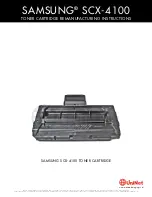
Wiring Coax Plugs and Coax Outlets
You will need to fit coax plugs to the aerial lead and to each of the leads
running to TV outlets so that they can be connected to the aerial amplifier.
1. Unscrew coax plug housing and slide cap over cable.
2. Strip 23mm of cable outer sheath. Gather copper braid, wrap around
outer sheath, slide claw over braid and crimp.
3. Strip 18mm of inner insulation to leave 5mm exposed.
4. Undo screw on plug/clamp, slide clamp over inner wire & tighten screw.
5. Reassemble plug and trim inner wire flush with plug.
Next run the cables from the amplifier to the surface outlet positions, if drilling
through walls be careful to avoid pipes and other cables. Use the cable clips
supplied to secure cables. Wire the surface outlets as shown below and use
the screws supplied to fix to a suitable surface such as a skirting board.
1. Strip 24mm of the outer sheath, pull back braid and tear off or cut off foil.
2. Twist braid together and wrap around inner insulation as shown, strip
12mm from inner insulation to expose central conductor.
3. Loosen terminal and saddle clamp screws and insert cable as shown in
Fig. 3. Tighten all screws and trim away any loose strands of braid.
1
2
3
4
5
1
2
3
Wiring Coax Plugs and Coax Outlets
Troubleshooting
Analogue Terrestrial TV
Snowy Picture
A faint, grainy or snowy picture is generally
caused by a weak signal. Normally the TV
transmitter will be a long way away. A possible
improvement could be made by reducing the
aerial downlead losses, installing a high gain aerial
and by adding a low noise masthead amplifier or
signal booster. In a small number of cases, a snowy
picture can also be caused by a TV signal that is
too strong.
‘Herringbone’ Pattern
‘Herringboning’ is generally caused by too strong
a TV signal or by a local high power transmitter
such as CB, amateur or taxi radio. Your TV sound
may be affected as well as the picture. Using an
attenuator will reduce the gain of an aerial signal
and improve the overall picture.
Digital Terrestrial Television
Unlike analogue TV signals which can still be
viewed under weak signal strength conditions,
with digital terrestrial signals blocking/freezing
and/or loss of digital picture and sound can be
caused by insufficient digital signal and carrier to
noise ratio.
Similarly blocking and even a completely blank
screen with no sound can result if the input signal
to the set top box is too high. The digital cliff refers
to the rapid change from the picture and sound
being perfect, to disappearing altogether.
For specific help with DTT reception problems,
log onto *www.digitaluk.co.uk/
No picture:
Check all connections from aerial to
TV.
Poor picture:
Check all connections from aerial
to TV.
Check aerial is properly aligned to the correct
transmitter.
If the aerial has been loft mounted try mounting
outside.
Make sure new digital coax cable has been used
throughout the installation.
Check the transmitter signal is not obstructed by
nearby trees or buildings.
If in a very weak signal area or for long cable runs,
installing a masthead amplifier will improve the
signal.
If in a strong signal area the signal strength may
need to be reduced by fitting an attenuator.
Intermittent Picture:
Make sure all RF cable
to connector joints are tight (both inner and
outer) including all flyleads and surface outlet
connections.
Amplifier Connections
UHF (TV)
Aerial
Main TV
VCR/DVR*
Freeview™
Receiver
VCR/DVR*
Aerial
Downleads
1. Connect your UHF aerial downlead to the input on your SLx amplifier.
2. If connecting to a digital TV with built in Freeview™ receiver connect one end of a TV aerial flylead to any of
the TV signal outputs 1, 2, 3, 4 on your SLx amplifier and the other end to the ANTENNA IN (ANT IN,
UHF IN) coax socket on your TV. This applies when the TV is in the same room as the amplifier.
3. For TVs situated in remote rooms connect the cable running to the remote coax outlet to any of the
outputs 1, 2, 3, 4 on your SLx amplifier. Connect one end of a TV aerial flylead to the surface socket and the
other end to the ANTENNA IN (ANT IN, UHF IN) coax socket on your TV.
4. For older TVs a separate Freeview™ set top or plug in receiver will be required. This should be
connected to the surface outlet by a TV aerial flylead to the ANTENNA IN (ANT IN, UHF IN) coax socket on
your Freeview™ receiver. The Freeview™ receiver will then usually be connected to a TV via a Scart lead.
5. If a video recorder or DVD recorder is to be included in the system this should be connected between the
amplifier/aerial outlet and the digital TV or for older TVs between the Freeview™ receiver and the TV.
**Please note that although satellite signals can be distributed using this kit, it will not be possible to control
your Sky™ box from the remote locations as
the SLx amplifier
doesn’t have a digital bypass.
Sky™ boxes can be connected locally to any of the TVs providing they have an individual feed from a satellite
dish. Sky™ box should be connected between Freeview™ receiver (if present) and TV or between Freeview™
receiver and VCR/DVR (if present) - see above.
TV Distribution Analogue and/or Digital plus optional VCR or DVR connection
Aerial Flylead/
Scart/HDMI
Aerial Flylead
Satellite
Receiver**
Aerial Flylead/
Scart/HDMI
Satellite
Receiver**
Aerial Flylead/
Scart/HDMI
Aerial Flylead/
Scart/HDMI
*VCRs, DVRs and
satellitereceivers
can be connected
as shown - if required.
FM/DAB
Aerial




















